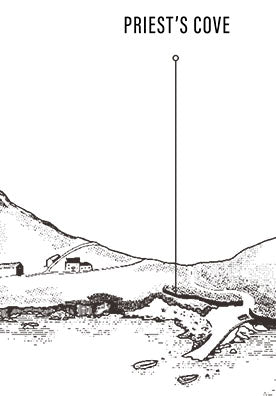One of the remaining structures of Cape Cornwall Mine, the Stack is an iconic tin mine chimney that sits atop the highest point of the cape. When the tin mine closed permanently and the engine house was demolished, it is said that the Stack was retained to help with navigation. The Stack dates back to 1864 and is a reminder that while Cornwall is as pretty as a picture book with rolling hills, peaceful cliffs and quaint fishing villages, it was once the centre the industrial revolution and a booming mining epicentre. The remains of mines, engines houses, smallholdings, ports, harbours, canals, railways, tramroads, and industries reflect an extended period of industrial expansion and prolific innovation. The Stack is part of the Cape Cornwall Mine which opened in 1838 when copper, tin and (later) arsenic production was in full force. It was common for tin mines to have chimneys like the Stack for ventilation - mines were powered by steam engines which pumped water out of them to prevent them from flooding. Chimneys dispersed the smoke from the engine house.
Two thirds of the world’s supply of copper was produced along
the Tin Coast (the area around St Just, Pendeen and Morvah in West Penwith) and Cornwall became famous for producing two million tons of tin in the 19th century. Metalliferous minerals were exploited from the 18th to the 20th century as the need grew. According to UNESCO, copper was mainly used to protect the hulls of ocean-going timber ships and tin was a key component for the canning of foods.
Mining activity in the area actually dates back to the Bronze Age due to the fact that Cornwall’s landscape is rich in metallic mineral deposits, particularly where granite and “killas” (mudstones and slates) meet. When mining was at its peak, around 25% of the Cornish population worked in mines. Interestingly, this included mothers and daughters who toiled as bal maidens (“bal”, meaning mine in Cornish), working “at grass” (above ground) crushing ore into smaller fragments, hammer on anvil, with only “gooks” (big hats) to protect their faces from debris and bad weather. Underground it was hot and dusty and men risked blasts, rock falls, drowning and machinery accidents - during this time period, to live to 30 or 40 was considered sheer luck.
As surface tin resources faded and new
regulations came into law, up to 500,000 people left Cornwall. Many headed to the California Gold Rush to use their skills and seek their fortune, others went to South Africa and Australia. Historians note that nearly six million people worldwide today are descended from migrant Cornish mine workers.
In 1987 Cape Cornwall was purchased for the nation by the
H. J. Heinz Company to commemorate a century of the company's operations in the United Kingdom. While the Stack is owned and maintained by the
National Trust, it features a Heinz Baked Beanz label-shaped plaque set into the base of the 1864 mine chimney.
Since 2006,
48 700 acres of Cornwall and West Devon have been inscribed as a UNESCO World Heritage Site. There are 10 areas in the World Heritage Site, each which tell a part of Cornwall’s fascinating and internationally significant mining history. From the innovative Cornish technology embodied in high-pressure steam engines to mining equipment exported around the world, the Stack is considered an authentic and historically important component of Cornwall’s rich mining heritage. It’s crowns the cape as a stark reminder of the area’s unforgettable contribution to the Industrial Revolution in Britain.









